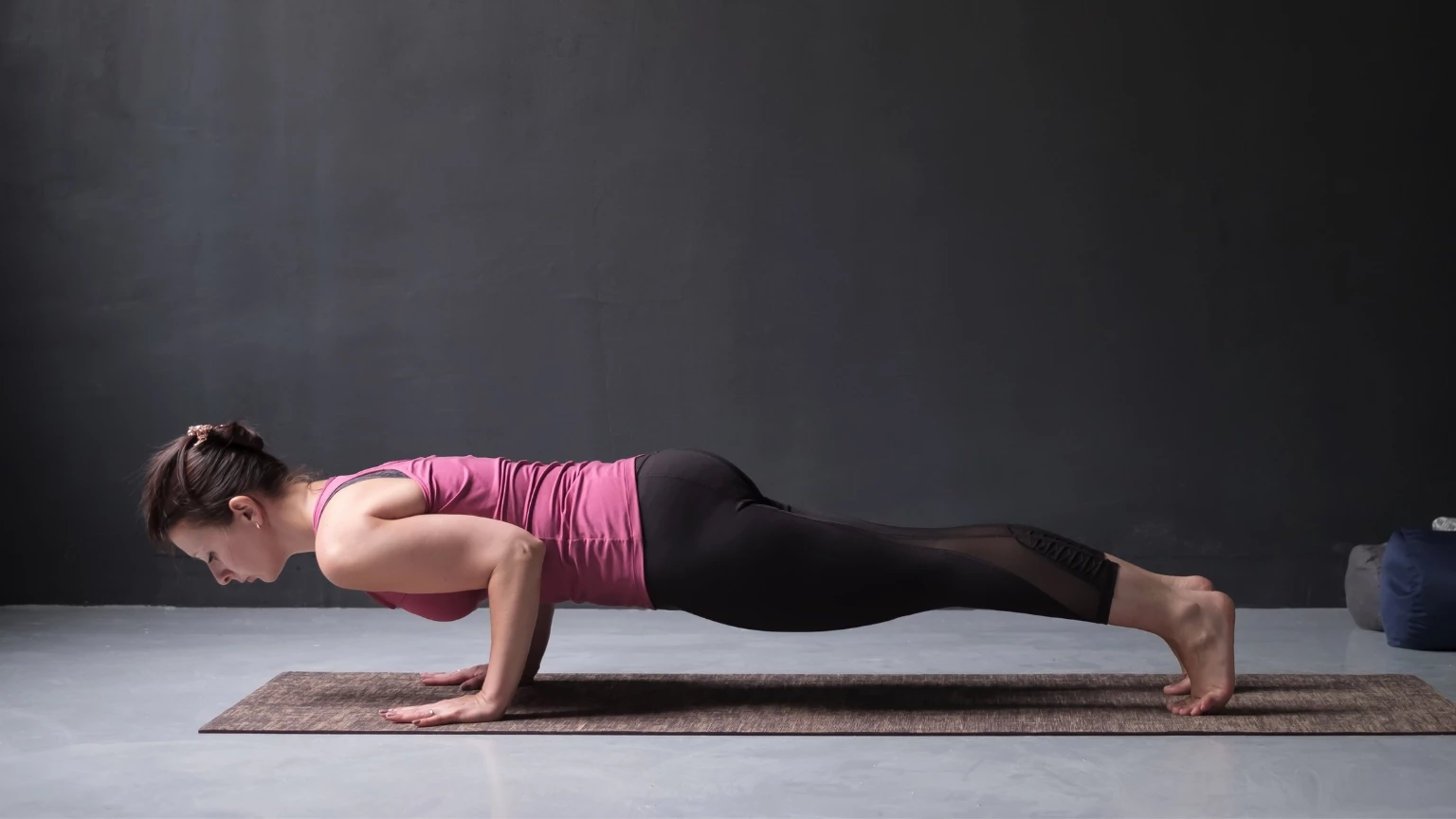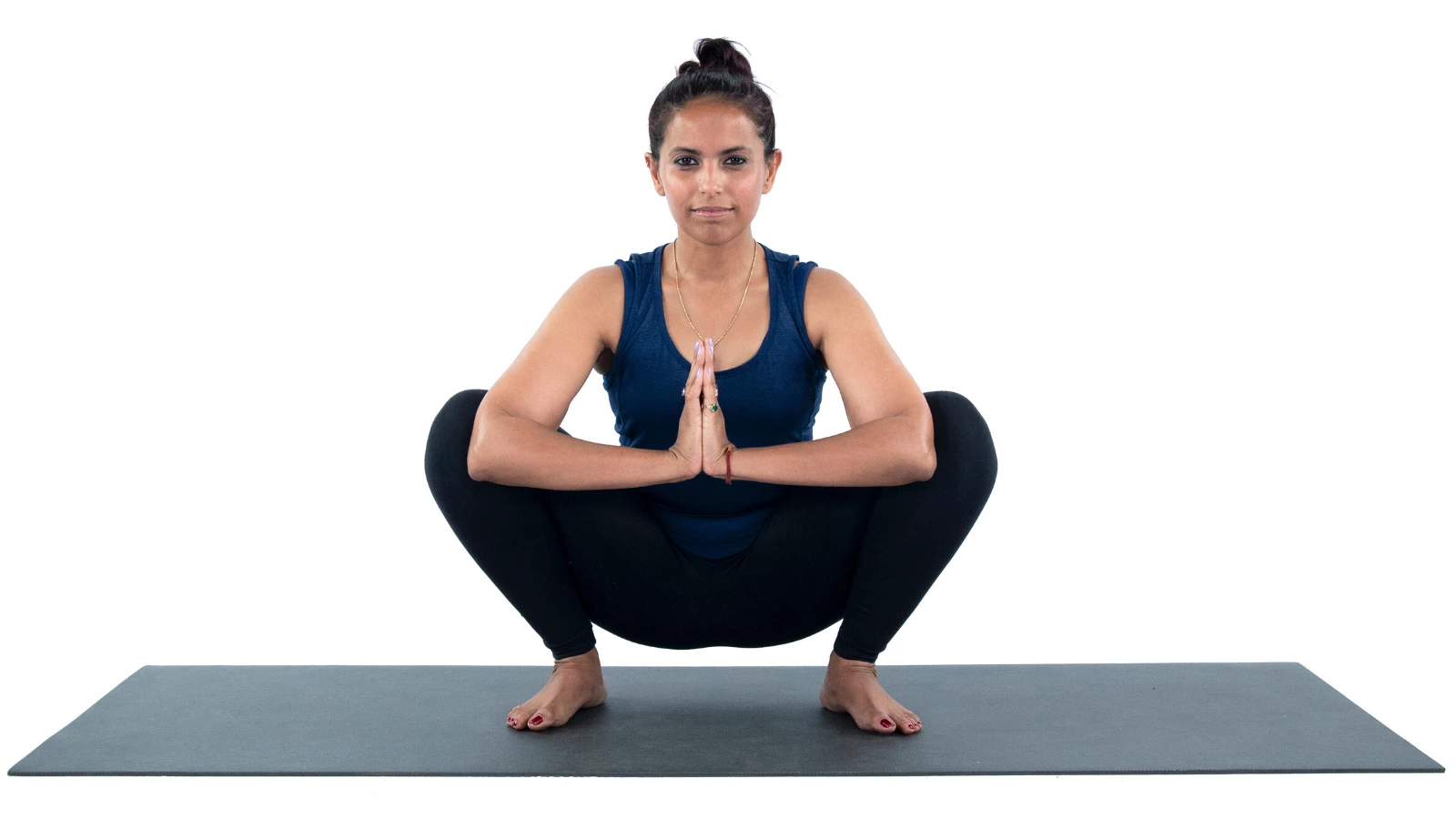Teaching Yoga: 5 Tips to Prepare for Arm Balances

Arm balances can be one of the hardest categories of yoga asanas to practice and teach. Not only do you have to prepare the body thoroughly for these challenging poses, but you also need a reliable sequence that makes sense and doesn’t tire the body out before arriving at the arm balance you plan to practice. This article aims to offer you five tips to prepare for arm balances, to sequence them and set you up for success.
1. Tips to Prepare for Arm Balances: Choose an Arm Balance
Arm balances are a vital part of the yoga practice, but they can be overlooked since they are so challenging. Regardless of the arm balance you choose, start by bearing weight on the hands and get familiar with the shape of the pose before doing it.
Before you can choose an arm balance, let’s define them: an arm balance is any asana in which your hands are your foundation.

This means Bharmanasana (Tabletop Pose), Phalakasana (Plank Pose) (above), Chaturanga Dandasana (Four-Limbed Staff Pose) (photo below) and Adho Mukha Svanasana (Downward Facing Dog Pose) are all arm balances. In fact, these are your fundamentals when it comes to balancing on your hands. Your arm balance sequence could very well be a sequence for Chaturanga Dandasana or Downward Facing Dog Pose, or it could be more complex such as Bhujapidasana (Shoulder Pinching Pose) or Parsva Bakasana (Side Crow Pose).
Choose a pose that you have a firm understanding of and also a pose that is appropriate for your practice level.
2. Tips to Prepare for Arm Balances: Start with Chaturanga Dandasana and Phalakasana for Shoulder Stability
No matter which arm balance you choose, you must begin with Chaturanga Dandasana and Phalakasana. These are fundamental to the shoulder stability in arm balances. (Yoga teachers, note that students who can’t flatten their shoulder blades onto their ribcage in Chaturanga Dandasana should skip Chaturanga and practice Phalakasana instead.)

Start with poses that are less demanding physically before working into the more demanding postures. Tabletop Pose is the best place to start getting a feel for how to use your hands in arm balances and to engage the serratus anterior, which holds the shoulder blades firmly against the ribcage.
3. Tips to Prepare for Arm Balances: Study the Shape of Each Arm Balance
Looking at the shape of an arm balance reveals the different types of poses that are helpful in creating an arm balancing sequence. One of my formulas for arm balances is adding a standing pose to an arm balance. For example, Malasana (Squatting Pose) (below) plus Chaturanga Dandasana equals Bakasana (Crow Pose) (with block, below).

Padmasana (Lotus Pose) plus Plank Pose equals Tolasana (Scale Pose). By stretching and strengthening the muscles of the hips in poses that are similar to your arm balance, you will properly prepare the body by the time you need to mobilize your hips into the arm balance.
4. Tips to Prepare for Arm Balances: Balance Between Warming the Body and Overworking the Body
Arm balances are challenging all by themselves, so an overly rigorous practice may not be the most optimal plan when sequencing for arm balances. You don’t to be so fatigued that by the time you get to the arm balance that you want to sit and move into Savasana (Relaxation Pose) instead.
The other element that needs to be balanced is “hand time.” How much time are you spending on your hands? You need to prepare your shoulders and wrists to bear weight, but you shouldn’t be on your hands for an extended time.
If you are a yoga teacher, to spread out teaching Phalakasana, Chaturanga Dandasana, and the arm balance, I would suggest teaching those fundamental elements first, placing them toward the beginning of your sequencing. Then add your standing and seated poses to take a break from being on the hands. Follow this by teaching the arm balance you’ve chosen.
5. Tips to Prepare for Arm Balances: Cool Down From Arm Balances
 In an arm balancing sequence, you’ve been on your hands and your feet. You’ve worked intelligently to hold your arm balance, and now you’re ready to simmer the body down. Leave enough room at the end of your sequence for quiet time.
In an arm balancing sequence, you’ve been on your hands and your feet. You’ve worked intelligently to hold your arm balance, and now you’re ready to simmer the body down. Leave enough room at the end of your sequence for quiet time.
Arm balances require the entire body to work, so there is no need to go into any deep stretches after the arm balancing. Garudhasana (Eagle Arms Pose) (right) can help to release the wrists and being supine calms the nervous system down.
Arm balances require a good deal of strength in the shoulders, chest, abdomen, and hip flexors. A supported backbend like Setu Bandha Sarvangasana (Bridge Pose) (below) with a block under the sacrum, or expanding the chest and shoulders by reclining over a bolster can be excellent counterposes to the active and demanding arm balances. End with a long Savasana for full-body, breath, and mind integration.
Any sequencing requires attention to details and practice. In teaching arm balances, there are multiple factors to be aware of, so it can take a considerable amount of time.
Planning an arm balance sequence is important because if you throw an arm balance into the mix before the body is ready, most people give up on arm balances before they even have the chance to practice them. By thoroughly introducing the elements of arm balancing (which include a thorough preparation of the hips), you are better able to prepare your body and direct your body and mind toward an experience that is conducive to practicing these challenging poses.

More yoga practice tips from Allison Schleck and YogaUOnline – Three Unique Ways To Prop Revolved Triangle Pose.
Study with YogaUOnline and Tias Little: The Spine As A Sacred Channel – Creating A Body Of Light, Vitality, And Energy.
Also, read...
Which Is the Best Way to Come Into Triangle Pose?
Nov 26 – Olga Kabel C-IAYT
Cat-Cow Pose (Marjaryasana-Bitilasana)
Oct 13 – By:
2 Restorative Yoga Poses to Calm Your Body and Mind
Oct 08 – By: Sue Dumais
Related courses

Allison Ray Jeraci, E-RYT 500, RPYT, is a vinyasa-based yoga teacher, fascinated by the intricate relationship between the mind and body. She offers a range of alignment-focused classes touching on anatomy, philosophy, and creative propping with a mindful approach. In addition to teaching group classes and managing the Yoga Culture studio in Danbury, CT, she also teaches at Open Door Family Medical Center in Westchester, NY, empowering mothers-to-be with prenatal yoga classes and childbirth education. You can find her @allisonschleck on Instagram and www.allisonrayjeraci.com.
Recent articles
Teaching Svadhyaya: 3 Ways to Encourage Self-Study in Yoga
Dec 15 – Meagan McCrary
In Celebration of Gray-Haired Yoga – Busting the Myth of the Yoga Body
Dec 12 – Charlotte Bell
Categories
Upcoming courses
Recent articles
Almost there...
Sorry, we couldn't find anything...
Yoga Practice Tips
Teaching Svadhyaya: 3 Ways to Encourage Self-Study in Yoga
As yoga teachers, our job is to teach yoga. This means more than…
Dec 15 – Meagan McCrary
Yoga Practice Tips
In Celebration of Gray-Haired Yoga – Busting the Myth of the Yoga Body
I found my first grey hair when I was 22. It wasn’t completely shocking.…
Dec 12 – Charlotte Bell
Yoga Practice Tips
Judith Hanson Lasater on The Art of Teaching Yoga: Making Every Movement an Asana
Judith Hanson Lasater is one of the longest-teaching yoga teachers in the U.S. In…
Dec 09 – By:




